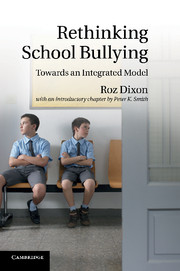Book contents
- Frontmatter
- Contents
- Acknowledgements
- Introduction
- 1 Bullying in schools: the research background
- 2 Understanding schools as systems
- 3 Bullying in groups: ostracism and scapegoating
- 4 Developing an integrated, systemic model of school bullying
- 5 Building personal bodies of knowledge to support research and practice
- 6 Building a public body of knowledge to support research and practice
- 7 Conclusion
- References
- Index
5 - Building personal bodies of knowledge to support research and practice
Published online by Cambridge University Press: 28 April 2011
- Frontmatter
- Contents
- Acknowledgements
- Introduction
- 1 Bullying in schools: the research background
- 2 Understanding schools as systems
- 3 Bullying in groups: ostracism and scapegoating
- 4 Developing an integrated, systemic model of school bullying
- 5 Building personal bodies of knowledge to support research and practice
- 6 Building a public body of knowledge to support research and practice
- 7 Conclusion
- References
- Index
Summary
In a sense we all have to develop some kind of idiosyncratic model. I think a lot of clinical psychologists are doing that. They have in some way been weaved together – these different strands – to make sense of the treatment for whoever they're working with. (Colin, clinical psychologist)
Chapters 2 to 4 describe in detail the development of a model that could be used to conceptualise bullying. However, each individual will inevitably build their own informal model or theory of bullying, based on their experience and their understanding of formal theories. This personal theory of bullying will underpin any action they take in relation to problems of bullying. This chapter describes some of the factors and processes that seem to be involved in developing these personal theories. It explores whether some ways of engaging with, managing and applying theory are likely to be more useful than others when problem solving.
The question of how different people develop their understanding of bullying arose whilst building the model described in Chapters 2 to 4. What became clear was that integrating theories into a coherent whole can be difficult, especially if they have been developed in isolation of one another. One possible approach to integrating theory is offered in Chapter 4. However, that approach represents only one possible solution. How, then, do other psychologists build and refine their personal theories of bullying?
- Type
- Chapter
- Information
- Rethinking School BullyingTowards an Integrated Model, pp. 141 - 173Publisher: Cambridge University PressPrint publication year: 2011



